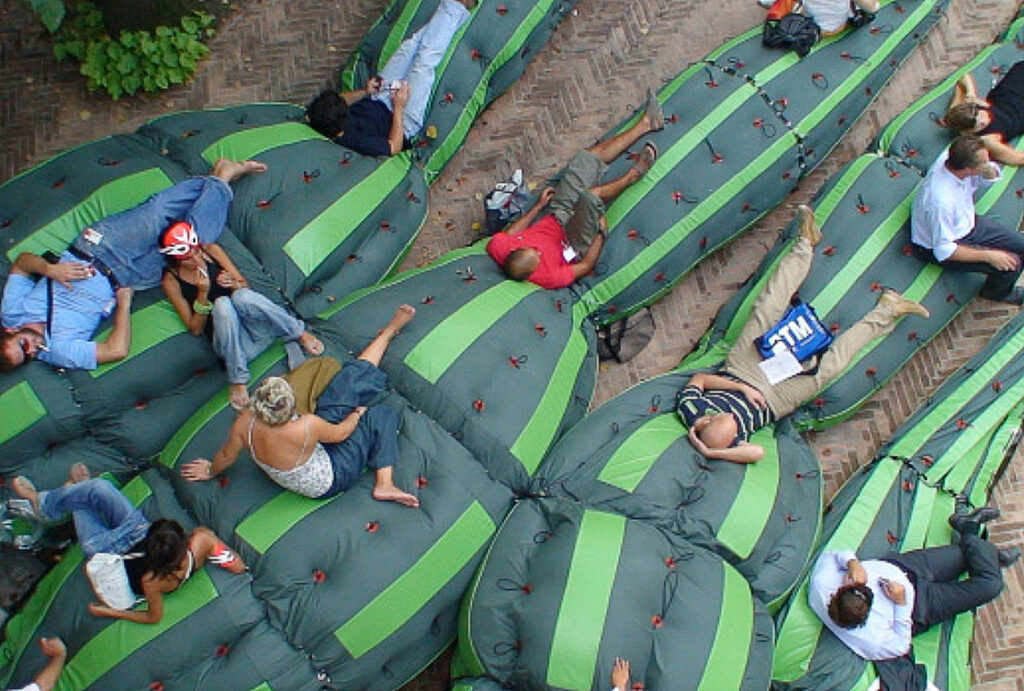| Project Type | Concept |
| Location | New Orleans, Louisiana, USA; Venice, Italy |
| Date | 2005-present |
| End User | Flood-prone neighborhoods |
| Design Firm | Anderson Anderson Architecture |
| Design Team | Mark Anderson, Peter Anderson |
| Manufacturers | Bay Rubber Company, New World Manufacturing, Seattle Tarp Company |
| Funder | Anderson Anderson Architecture; US Department of State |
| Cost per unit | $3200 USD |
| Volume | 8300 liters per sponge |
| Length | 12 m/40 ft |
| Diameter | 2.4 m/8 ft |
What if a levee could expand and contract, swelling and receding with the water’s flow? What if a floodwall could help retain soil along fast-eroding shorelines? What if a floodwall wasn’t a wall at all?
These are the questions Hurricane Katrina raised for brothers Mark and Peter Anderson, of San Francisco’s Anderson Anderson Architecture, when they entered a design contest organized to find solutions for a 160-unit housing complex in New Orleans, Louisiana. The brothers’ entry in the High Density on the High Ground competition focused on a corner in the city’s Marigny District, along the Mississippi River. It sought to prevent floods and riverbank erosion with the Alluvial Sponge Comb, a configuration of polyvinylchloride (PVC) bladders filled with super-absorbent polymers like those used in diapers.
These bladders, capable of absorbing 1000 times their weight, create fingers that are placed perpendicular to the waterfront in a comb formation. Spacing between the fingers allows people and wildlife to move between land and water during appropriate conditions. The comb’s “teeth” dangle in the water, slowing flow to minimize erosion. Floodwaters rise until reaching the absorbent section and the polymers expand to create a larger barrier. Once the floodwaters recede, retained water evaporates and they revert to their original form.


top image: People lounging and enjoying the Combs at the 2006 Venice Biennale. Photo: Anderson Anderson Architecture
bottom image: Visualization of proposed deployment. The fingers of each Comb are portable and can be rearranged. For example, a low-lying riverbank or estuary could be changed as environmental conditions such as rising sea level warrant. Photo Anderson Anderson Architecture
The opportunity to build and display a prototype of this design concept came in 2006 at the Venice Biennial. At half the size of the New Orleans design, the Alluvial Sponge Comb model greeted visitors to the US Pavilion with a playground feel. “People love them,” architect Peter Anderson says. “They love to touch them, to get up close to them, to sit on them; it is important that they are approachable.”
The brothers would like to collaborate with polymer manufacturers and hope their marketing efforts will attract interest in Alluvial Sponge Combs as a viable flood control option, potentially in markets where traditional flood control measures are cost-prohibitive. Currently production costs $2000 USD per finger, however they are willing to license the product royalty free to nonprofit organizations that are willing to test them out. The Alluvial Sponge Comb has been exhibited around the world, but as a small company Anderson Anderson Architecture has not had the resources to distribute it.


Once the combs expand with absorbed water they create an 8-foot barrier wall. Image: Anderson Anderson Architecture
















READ OR LEAVE A COMMENT